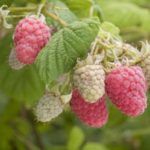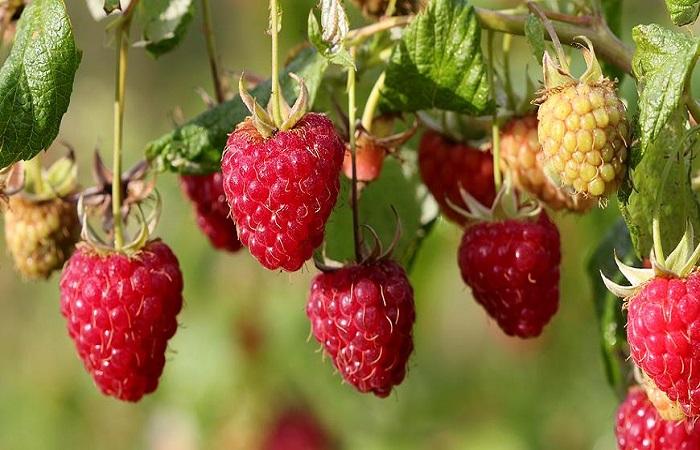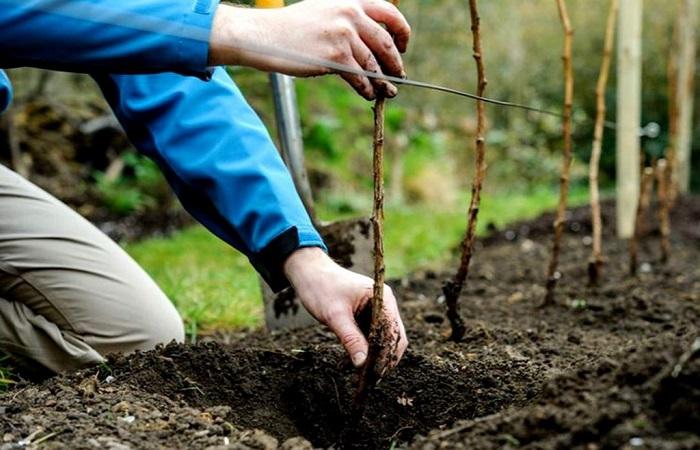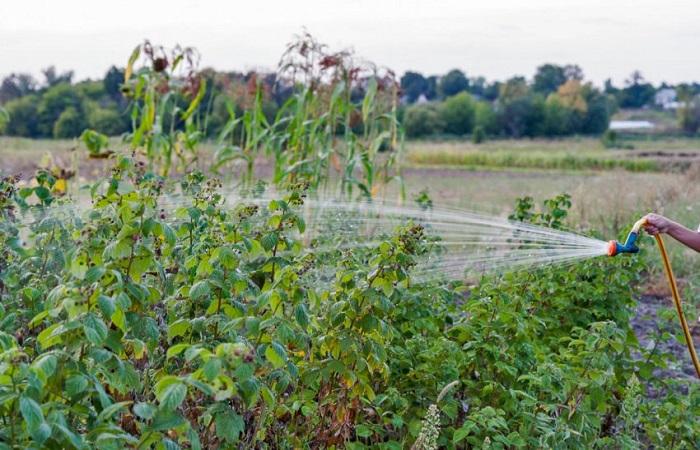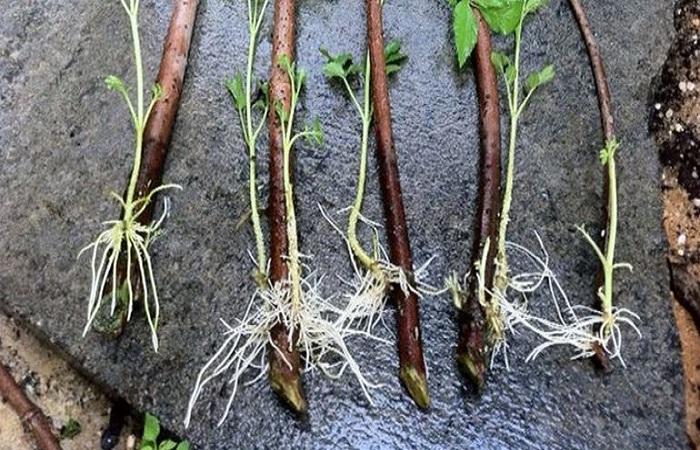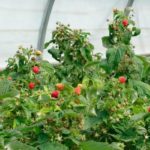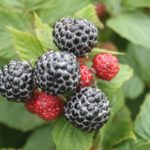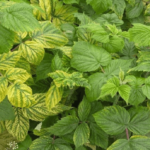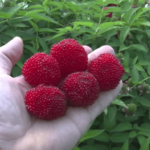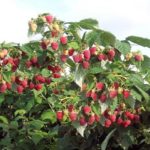Raspberries are a tasty, aromatic and very healthy berry. But ordinary varieties bear fruit for a short time, so breeders have developed remontant varieties, that is, capable of bearing fruit repeatedly or repeatedly throughout the season. In relation to raspberries, remontance means the ability to bear fruit on both two-year-old and one-year-old shoots. This ability is fully demonstrated by the remontant raspberry variety Brilliantovaya.
Description and characteristics of Diamond raspberries
This raspberry variety got its name because of the pronounced sparkle of the berries. Diamond was created by the Russian breeder Kazakov. This is an early remontant raspberry for universal use.
Forms spreading bushes with shoots up to 1-1.5 meters long. They lie down under the weight of the harvest, so they require garter. The shoots are partially covered with soft spines of medium length, mainly located in the lower part of the plant. The branches are colored light brown, which turns purple on annual shoots in the fall. There is a significant waxy coating and slight pubescence. The foliage is wrinkled, medium in size, green, tinged with reddish or purple, and has a jagged edge.
Diamond raspberry berries are large, cone-shaped, identical in size, ruby colored, with delicate sweet and sour pulp with a dessert taste, without aroma. On average, a berry weighs 4 grams.
The fruiting season starts in August and lasts all autumn until frost. Diamond raspberry is highly resistant to elevated temperatures and has average resistance to soil drought.
Advantages and disadvantages
Raspberries of the Brilliant variety attract with positive characteristics and beneficial qualities:
- Versatility of use. Berries can be successfully consumed both fresh, frozen and processed.
- Heat resistance.
- Remontability is the tendency to bear fruit for a long period and on shoots of different years.
- High taste characteristics and nutritional value.
- Minimal or complete absence of thorns.
- Abundant harvest.
- The ability to cultivate in regions with fairly cold winters (if there is shelter or abundant snow cover).
- With increased water supply (for example, in years with heavy spring and summer rainfall), it produces a large harvest of larger and juicier berries.
- Calm attitude towards growing on different types of soils, with the exception of acidic, saline and waterlogged ones.
- Average resistance to soil drying out - will survive short droughts without loss.
- Resistance to a number of diseases and pests.
There are few disadvantages to the Brilliantovaya raspberry variety:
- The delicate consistency of the berries causes insufficient transportability.
- The need for gartering of spreading bushes with long shoots.
- Poor resistance to long periods of drought.
- With prolonged fruiting, not all the berries of the last wave may have time to ripen.
The minimum number of negative traits and many positive qualities have made the Brilliantovaya raspberry a sought-after and popular variety, both among summer residents and among farmers who grow it for sale or processing.
Growing and caring for the variety
Diamond raspberry is zoned for cultivation in the Central and Central Black Earth regions of the Russian Federation, but can successfully grow in other places. You can get up to 3 kilograms of berries from a bush.
In order for the plantings to bear fruit abundantly, you need to use the correct agricultural technology and provide the bushes with competent, systematic care.
Selection of seedlings
To obtain healthy bushes, seedlings must be strong, with healthy, well-developed roots and at least three renewal buds at the base of the branch. It is important to ensure that the roots are not overdried - such seedlings may not be accepted, and those that do survive will suffer for a long time and are unlikely to produce a harvest in the year of planting.
Landing dates
Brilliant raspberries are planted in the central zone of the Russian Federation from October until the onset of frost. Bushes require a sunny location in areas where there is no stagnant moisture or groundwater close to the surface. In regions with frosty winters, it is better to choose the south side and parts of the garden protected from cold winds for these purposes.
Landing algorithm
Diamond raspberries are planted in holes 35 x 30 centimeters filled with nutritious soil mixed with long-acting complex mineral fertilizers. You can also add organic matter to the planting holes.
The distance between plants should be 70-90 centimeters, in rows - 1.5-2 meters.
Watering and fertilizers
Raspberries equally do not tolerate drought or overwatering, so during the growing season three abundant moisture recharges are practiced:
- At the beginning of the growing season.
- During the formation of the harvest.
- After picking berries.
Newly planted plants are also watered. Plantings require regular fertilizing with organic and mineral fertilizers. They are added according to the natural rhythms of raspberry development: nitrogen - in the spring, at the beginning of active growth of shoots, potassium - during flowering and setting berries, superphosphate - for ripening shoots and strengthening plants.
Pruning rules
Diamond raspberry produces numerous shoots. To avoid overloading the bush, it is recommended to leave no more than 5 of the strongest shoots. The rest are cut out and used for rooting and propagation of the variety.After planting, the seedling is pruned to a height of no more than 20 centimeters.
Wintering
The plant overwinters well under snow cover and tolerates even severe frosts. It is important that the site is not located in windy or too high places, where the wind quickly blows away the snow cover and the cold air flow dries out the plantings.
Reproduction
To obtain new seedlings, shoots that form at the base of the bush are cut off and rooted as cuttings. It is also possible to use other propagation methods, for example, layering.
Disease and pest control
Raspberries are susceptible to raspberry beetles and gall midges, red spider mites, and can also suffer from rot and fungal diseases. If signs of disease or pests appear, treat with appropriate pesticides.
Collection and storage
Brilliant raspberries are delicate and sensitive, so they need to be collected carefully, using containers with low sides and a flat bottom. The product should be processed or consumed as soon as possible, stored at a temperature of 3-5 degrees, preferably no more than 24 hours.
The harvest can be consumed fresh, frozen or turned into compote, preserves, marmalade or marmalade.




